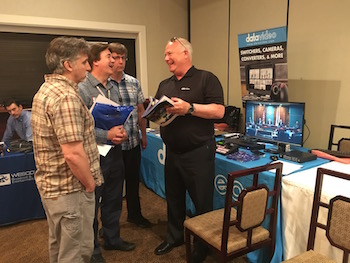The Future of Streaming and Wireless Audio Revealed at the Duncan Video Technology Showcase


Duncan Video's annual Product Showcase brought together 36 AV and broadcast vendors, including Datavideo Technologies. Before there was social media marketing, there was social marketing. Community members gathered together to make new contacts, foster existing relationships, and share some knowledge. And ideally, there was some good nosh to be had.
Fortunately for those who appreciate the power of meetings, social marketing is still alive and well. In fact, it appears to be expanding. Following the consolidation of AV industry trade shows into one or two major annual events, and perhaps even spurred by online networking that naturally leads to in-person meetings, local and regional technology showcases are taking on the characteristics of mini marketplaces complete with training programs.
Take the case of Duncan Video’s annual Product Showcase, which for 25 years at the Ritz Charles event center in Carmel, IN, has brought customers together with sales and engineering team members for product demos, training, and the requisite good nosh. This year’s event, on May 23, featured 36 top-level AV and broadcast vendors. On average, the company receives RSVPs for some 200 guests from Duncan Video’s home state of Indiana and surrounding states of Illinois, Michigan, Kentucky, and Ohio.

The Duncan Video showcase has been likened to a block party, where people can drop in and catch up with their peers. Above, attendees meet with representatives from Ross Video.At an event that vendors credit with being one of the best on their calendar, clients old and new mingle with team members from across the company’s history. It’s like a neighborhood block party, where people drop in to catch up and new visitors get the chance to learn from their peers. “It’s a big relationship thing,” said Danny Tuttle, a Duncan Video sales representative who handles marketing for the company. “With Duncan being a smaller company, that’s one of the key factors in the show. We talk to these people on the phone a lot, but this is a good excuse to catch up in person.”
The evolution of Duncan Video’s showcase reflects changes occurring throughout the AV industry. With roots in broadcast, the company has responded to demands for its technology in house of worship and university applications, as well as a growing corporate presence. The latter, Tuttle said, is one of the newest extensions of the firm’s skillset: “We’d like to start diving into the corporate market some more,” he said, pointing to that vertical’s increasing demand for streaming video and other broadcasting solutions.
Indeed, it seems that every market is looking for tools to deliver a message to a variety of screens. In house of worship, Tuttle said, clients are continuing to seek ways “to put the service up on some sort of large-scale display and simultaneously send it to the website or satellite campuses. They want to stream it, store it on the web, and present it to the live audience, all at once—and all on a budget.”
In higher ed, Duncan Video is seeing consistent interest in updates to existing broadcast facilities. Expansion tends to come with growth in sports coverage in particular, and the tools required have to be versatile enough for use in the studio and outside on the field. “Usually it’s the same team doing both,” Tuttle observed.
A daily selection of the top stories for AV integrators, resellers and consultants. Sign up below.
Lecture capture is also driving updates in higher ed, and in addition to technology for recording and distribution, that also means new infrastructure updates. “A current trend we’re seeing with customers is that in older spaces where it’s not easy to run brand-new cable builds, they’re looking at different streaming devices that can use the existing network.”
Looking ahead to the rest of the year based on the conversations had at the Technology Showcase, Tuttle predicted growth in the government and corporate spaces, the latter because of the aforementioned streaming solutions, and the former because of new requirements for wireless audio spectrum use.
Those changes will of course affect many commercial installs, and the manufacturer training offerings at the Duncan Video Technology Showcase wisely included a Shure session on changes to the wireless microphone spectrum following the latest FCC auction. That presentation drew a crowd, as did the other sessions on the agenda, including a look at IP workflows presented by AJA, and two more presentations by Sony and Ross Video on solutions tailored for new trends in integration.
Networking and knowledge were in abundance at the event, and the nosh was in good order as well. That was a relief to many Duncan Video guests, as a certain reputation has been established for the delicious meatballs provided on the menu every year at the event. “Everybody loves those meatballs,” Tuttle said. “They changed the recipe one year, and we got a lot of negative feedback about it.”
